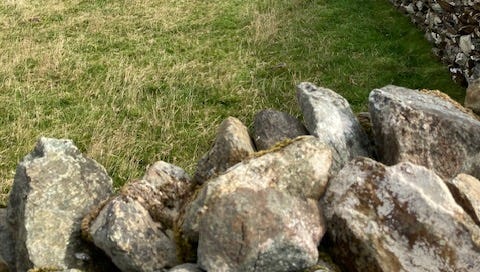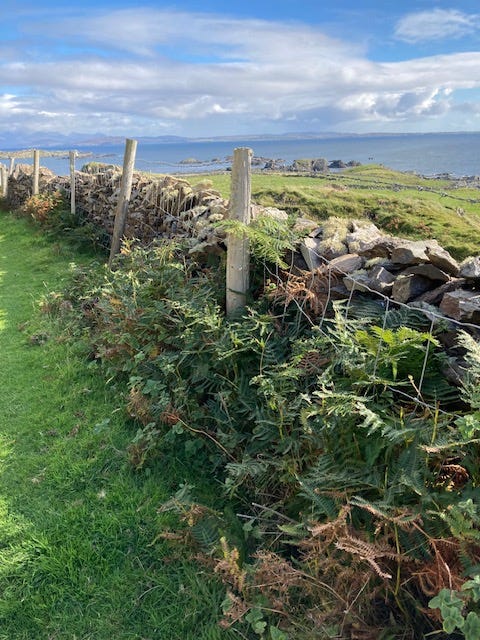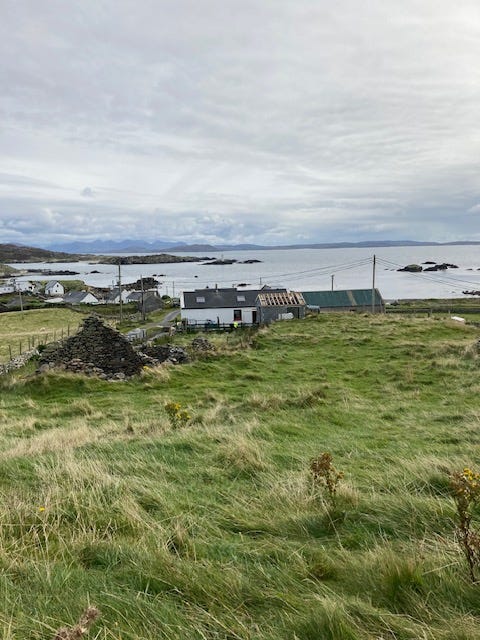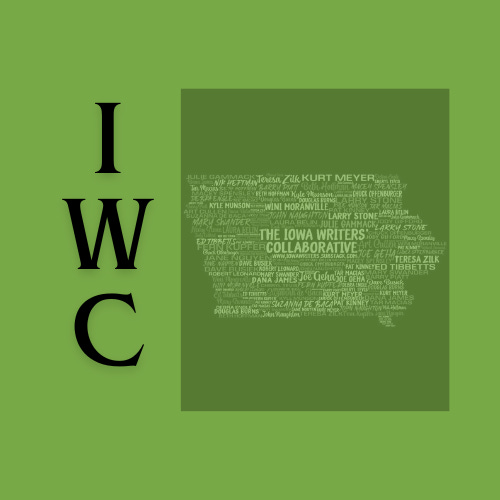The season of life perpetually meets the season of death in the Children’s Cemetery on Inishbofin Island, Ireland. It takes a sharp eye to find the graveyard, tucked away off the path on the way to the Stags, a series of rocky peaks, rising from the sea and home to a seal colony.
You climb up through the bog, each step a little more slippery, a little more uncertain, imagining the souls of the small children hovering over their stone markers. The wind whips the grass. Sheep graze between the stones—plain unnamed rocks scattered here and there, seemingly at random in a circular formation, a configuration suggesting an ancient historical settlement.
Who were these children? How long had they been buried here? How long had they lived before they met this fate? Why were they clustered together like this and not buried with their families in St. Colman’s cemetery on the other side of the island?
These were the unbaptized, those who died too soon for the sacrament to be performed. These were the miscarriages, stillborns, the babies who lived just an hour, not long enough to ferry the priest from the mainland to perform the rite. These were the babies buried in unconsecrated ground. These were the babies in Limbo, that in between place where souls floated, unmoored.
No saint’s name was attached to this cemetery, just centuries of cannon law, custom and superstition. The absence of a saint’s name gave the Children’s Cemetery an eerie, anonymous feeling. It was blank, without personality, story or metaphor. It so reminded me of an Amish cemetery in the States, the plain stones lined up without decoration or mythology. No angels carved into marble. No little token offerings placed near the graveside. No tiny currachs or cribs. Nothing to connote the family. And certainly, no saint’s name. And it wasn’t as if the Irish didn’t have a vast array of saints to choose from.
By the twelfth century monasteries dotted the Emerald Isle. Catholic monks brought a new religion to the land, and with this new belief system came a new concept called “saints.”
“What’s a saint?” the Irish pagans asked.
“A saint is a very good and holy person,” the monks said.
“Oh,” said the Irish. “My Uncle Sean is a good person. He’s a saint! St. Sean.”
“Well, my sister Siobhan is also a very good person. St. Siobhan.”
And on and on it went until half the people in Ireland had been declared “saints.” Yet not one of them lent their namesake to this stretch of land. And if you didn’t know what you were looking for, you might think you were just passing another pasture, another spot to stop and look back down on the bay, the harbor that had seen great comings and goings, from seafarers to St. Patrick, from Vikings to Cromwell. In the water, you might get a glimpse of your own reflection. You might sense a connection to your lineage here that stretches back to Bronze Age. But what link do you feel to this circle of stones, to these rocks that seem to hide themselves away from the world?
“Now we will pray for the babies in Limbo,” I remember the nun in our 1959 Catholic school leading us all in the Our Father.
“What are we praying for?” I asked. “Can we get those babies out of Limbo?”
“No, they are there for good. We pray to ease their suffering.”
That afternoon I got off the school bus and quizzed my mother on this theological concept. “How were those babies supposed to get themselves baptized? Why should they suffer? Who came up with this idea anyway?”
“Out of the mouths of babes” my mother simply said.
Through no fault of their own, no sin that they had committed, mere babies were condemned to a lower rung of hell. At least, Stingy Jack, Jack-o-lantern in hand, could wander in search of an escape. But these babies were stuck. They didn’t even have their families nearby to give them comfort. How did this happen?
The last child was buried in the Inishbofin Children’s Cemetery around 1970, but the ban wasn’t officially lifted until 1992 when the Catholic Church removed all mention of Limbo from their catechism. A century-old certainty was gone. The church shifted its beliefs toward trusting God’s mercy toward unbaptized children.
The history of children’s cemeteries goes back to ancient times. In June of 2024, archeologists uncovered a large Roman cemetery in France with 250 burials of stillborns and young infants. The cemetery, located outside the city walls, dated form the first to third centuries A.D. In Christian times, the Church believed that dead baby’s bodies would pollute holy, consecrated ground. So cemeteries were built at some distance from a church or a population center.
In his Divine Comedy (written 1321), Dante wrote of the lost souls in Limbo, both the infants, but also other unbaptized men and women.
The good master said to me, “You do not ask
What souls these are that you observe here?
I want you to know before you go on,
That they have not sinned, but their great merits
Are not enough, because they lack Baptism
Which is a gateway to the faith that you hold.
The unbaptized carried not only grief, but shame and blame. With little available medical intervention, midwives prayed to saints to help with difficult births. Often the saints let the midwives down. The unbaptized souls who ended up in cemeteries were the lucky ones. Throughout Europe, these babies could be found tucked away under floor boards, or squeezed between the gaps in stone walls.
My mother grieved the baby she lost, her last child—a boy, a miscarriage, born four years after me. My mother spent day after day in bed, cared for by my grandmother and a neighbor woman. I didn’t know what was wrong. Was my mother sick? But with what? Was she dying? No one talked, no one explained, but prayers went up to the Virgin Mary and one saint after another.
Then one night, something was happening. My grandmother huddled with my mother in the bedroom. I sat out of the way on the stairs. Whatever was going on was over by the time the town doctor lumbered past me to the bedroom. Then my grandmother, my Irish grandmother, was on the stairs with a tiny bundle in her arms. She went down to the kitchen and placed it in a shoebox. In the middle of the night, she buried it in the garden.
At the Children’s Graveyard, Inishbofin Island
Take us now, stillborns
slipped between stones,
blue babies dug into the bog,
Unbaptized, we who were pushed
out too soon, barely able to breathe
or latch to a breast.
Take us now into the deep grief
of the unknowing,
Of what could have been—
the sheep, the cottage,
thatched roof, the family
sitting around the hearth.
Take us now up into your
forever orbit, lost souls,
lost planets, spinning
between heaven and hell,
turning until the day of
the earth’s final unraveling.
Take us now.
Deliver us.
--Mary Swander
I am honored to be part of the Iowa Writers Collaborative. Read and follow our work here:









45 years after my miscarriage, I gave her a name. Elizabeth.
Thank you for telling the stories of these babies and the women who suffered, lost in the limbo of their grief. Thank you for giving the lost planets a voice in your beautiful poem prayer.